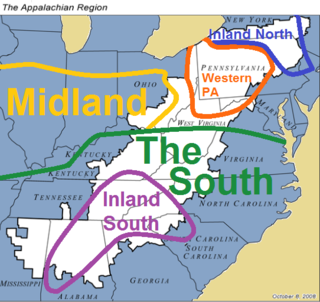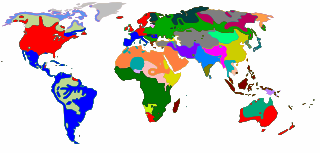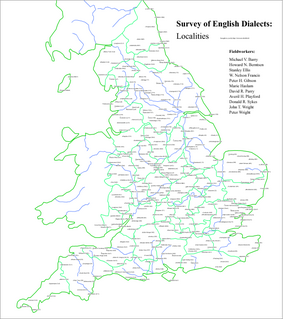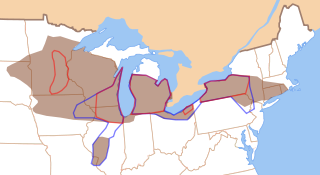Related Research Articles

Western Pennsylvania English, known more narrowly as Pittsburgh English or popularly as Pittsburghese, is a dialect of American English native primarily to the western half of Pennsylvania, centered on the city of Pittsburgh, but potentially appearing in some speakers as far north as Erie County, as far west as Youngstown, Ohio, and as far south as Clarksburg, West Virginia. Commonly associated with the white working class of Pittsburgh, users of the dialect are colloquially known as "Yinzers".
In the field of dialectology, a diasystem or polylectal grammar is a linguistic analysis set up to encode or represent a range of related varieties in a way that displays their structural differences.

The Dictionary of American Regional English (DARE) is a record of American English as spoken in the United States, from its beginnings to the present. It differs from other dictionaries in that it does not document the standard language used throughout the country. Instead, it contains regional and folk speech, those words, phrases, and pronunciations that vary from one part of the country to another, or that we learn from our families and friends rather than from our teachers and books. For DARE, a "region" may be as small as a city or part of a city, or as large as most of the country. Humanities magazine has described it as "a bold synthesis of linguistic atlas and historical dictionary", and William Safire called it "the most exciting new linguistic project in the twentieth century".

The Linguistic Society of America (LSA) is a learned society for the field of linguistics. Founded at the end of 1924 in New York City, the LSA works to promote the scientific study of language. The society publishes two scholarly journals, Language and the open access journal Semantics and Pragmatics. Its annual meetings, held every winter, foster discussion amongst its members through the presentation of peer-reviewed research, as well as conducting official business of the society. Since 1928, the LSA has offered training to linguists through courses held at its biennial Linguistic Institutes held in the summer. The LSA and its 3,600 members work to raise awareness of linguistic issues with the public and contribute to policy debates on issues including bilingual education and the preservation of endangered languages.
Dialectology is the scientific study of linguistic dialect, a sub-field of sociolinguistics. It studies variations in language based primarily on geographic distribution and their associated features. Dialectology treats such topics as divergence of two local dialects from a common ancestor and synchronic variation.
Clive Upton is an English linguist specializing in dialectology and sociolinguistics. He is also an authority on the pronunciation of English. He has been Emeritus Professor of Modern English Language at the University of Leeds since 2012.
A diaphoneme is an abstract phonological unit that identifies a correspondence between related sounds of two or more varieties of a language or language cluster. For example, some English varieties contrast the vowel of late with that of wait or eight. Other English varieties contrast the vowel of late or wait with that of eight. This non-overlapping pair of phonemes from two different varieties can be reconciled by positing three different diaphonemes: A first diaphoneme for words like late, a second diaphoneme for words like wait, and a third diaphoneme for words like eight.
Bernard Bloch was an American linguist. He taught at Brown University and was Professor of Linguistics at Yale University.

A linguistic map is a thematic map showing the geographic distribution of the speakers of a language, or isoglosses of a dialect continuum of the same language. A collection of such maps is a linguistic atlas.
Swamp Yankee is a colloquial term for rural Yankees. The term "Yankee" connotes urbane industriousness, whereas the term "Swamp Yankee" suggests a more countrified, stubborn, independent, and less-refined sub-type.
Guy Somner Lowman Jr. was an American linguist who received a bachelor's degree from the University of Wisconsin–Madison in 1929 and a Ph.D. in Philosophy from the University of London in 1931. From 1931 to 1933 he was a Sterling Fellow at Yale University. He worked as chief field investigator for the Linguistic Atlas of the United States and Canada from 1931 to 1941, interviewing more than a thousand informants along the eastern seaboard of the United States and Canada. He also conducted field interviews in Southern England to find correspondences in English and American dialects. He was a member of the Modern Language Association and served as chairman of the phonetics section.

The Survey of English Dialects was undertaken between 1950 and 1961 under the direction of Professor Harold Orton of the English department of the University of Leeds. It aimed to collect the full range of speech in England and Wales before local differences were to disappear. Standardisation of the English language was expected with the post-war increase in social mobility and the spread of the mass media. The project originated in discussions between Professor Orton and Professor Eugen Dieth of the University of Zurich about the desirability of producing a linguistic atlas of England in 1946, and a questionnaire containing 1,300 questions was devised between 1947 and 1952.
Hans Kurath was an American linguist of Austrian origin. He was full professor for English and Linguistics at the University of Michigan, Ann Arbor. The many varieties of regional English that he encountered during his trips convinced Kurath of the necessity of completing a systematic study of American English.

Northern American English or Northern U.S. English is a class of historically related American English dialects, spoken by predominantly white Americans, best documented in the greater metropolitan areas of Connecticut, Western Massachusetts, Western and Central New York, Northern Ohio, Northern Illinois, Wisconsin, the Lower Peninsula of Michigan, and Eastern South Dakota, plus Northern New Jersey, Northeastern Pennsylvania, Iowa, and Minnesota. The North as a super-dialect region is considered, by the 2006 Atlas of North American English (ANAE), at its core, to consist of the dialects of the Inland North and Southwestern New England.
Despite popular stereotypes in the media that there is a singular New Jersey accent, there are in fact several distinct accents native to the U.S. state of New Jersey, none being confined only to New Jersey. Therefore, the term New Jersey English is diverse and often misleading, and it may refer to any of the following dialects of American English, or even intermediate varieties that blend features of these multiple dialects.
The Linguistic Atlas of Chinese Dialects, edited by Cao Zhiyun and published in 2008 in three volumes, is a dialect atlas documenting the geography of varieties of Chinese. Unlike the Language Atlas of China (1987), which maps the distribution of both minority languages and Chinese dialect groups, the new atlas is a collection of maps of various features of dialects, in the tradition of the Atlas linguistique de la France and its successors.
Perceptual dialectology is the study of how nonlinguists perceive variation in language—where they believe it exists, where they believe it comes from, how they believe it functions, and how they socially evaluate it.
Western New England English refers to the varieties of New England English native to Vermont, Connecticut, and the western half of Massachusetts; New York State's Hudson Valley also aligns to this classification. Sound patterns historically associated with Western New England English include the features of rhoticity, the horse–hoarse merger, and the father–bother merger, none of which are features traditionally shared in neighboring Eastern New England English. The status of the cot–caught merger in Western New England is inconsistent, being complete in the north of this dialect region (Vermont), but incomplete or absent in the south, with a "cot–caught approximation" in the middle area.

The Latin turned alpha, also known as the turned script A, is an additional letter of the Latin script, based on letters A and Latin alpha (Ɑ). Its lowercase variant is used in International Phonetic Alphabet, Americanist phonetic notation, Uralic Phonetic Alphabet, Teuthonista, Swedish Dialect Alphabet, Dania, and Norvegia transcriptions. Its upercase variant is used in the Americanist phonetic notation. The letter also apperears in Belter Creole, a constructed language made by Nick Farmer for The Expanse television sci-fi series.
Julia McDonnell Bloch was an American linguist. She was on the editorial staff of the Linguistic Atlas of New England (1939-1943), assisting in the preparation of its 700 dialect maps. She also contributed to the Handbook of the Linguistic Geography of New England. These books were part of a Linguistic Atlas project directed by Hans Kurath.
References
- ↑ Algeo, John (2010). The Origins and Development of the English Language (6 ed.). Boston: Wadsworth. p. 196. ISBN 978-1-4282-3145-0.
- 1 2 3 "LAP Online - Linguistic Atlas of New England". www.lap.uga.edu. Retrieved 2017-04-07.
- 1 2 3 4 5 6 7 Kurath, Hans (1973). Handbook of the linguistic geography of New England (Second ed.). New York: AMS Press. pp. xi–xii. ISBN 0404100473. LCCN 70-37508.
- ↑ Nina, Brown (2001-01-01). "Hans Kurath, Linguistic Atlas of the United States". EScholarship.
- ↑ Perkins, George (1991). "Linguistic Atlas of the U.S.". Benet's Reader's Encyclopedia of American Literature. 1. HarperCollins. p. 615.
- ↑ "Linguistic Atlas of New England – Special Collections and University Archives". scua.library.umass.edu. Retrieved 2017-04-07.